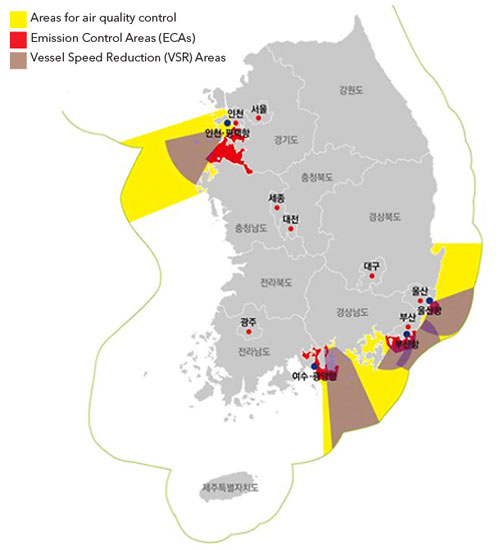15 May 2020
Applicability: Ship owners and operators trading to South Korea.
From 1 September 2020, the South Korea government will implement mandatory SOx Emission Control Areas (SECAs) requiring the use of 0.1% sulphur fuel by ships in specified port areas. The South Korea government has also released a voluntary speed reduction program in the same ports.
New Korean SECAs*
Effective from 1 September 2020, the following seaport areas become Korean SECAs:
- Incheon (including Gyeongin port)
- Pyeongtaek·Dangjin
- Yeosu·Gwangyang (including Hadong port)
- Busan
- Ulsan
(*Please see the attachment for more details of the above applicable areas)
New sulphur fuel limits
Effective from 1 September 2020, all ships (including foreign-flagged vessels) berthed or at anchorage in the above SECAs must ensure that, one hour after mooring (or anchoring) and one hour before de-berthing (or heaving anchor), sulphur content of fuel oils used on board does not exceed 0.1% m/m (or an approved equivalent arrangement is used).
Effective from 1 January 2022, all ships (including foreign-flagged vessels) entering or leaving the SECAs must comply with the same 0.1% m/m sulphur fuel limit using the appropriate fuel oils (or approved equivalent arrangement).
Approved equivalent arrangement
The use of an exhaust gas cleaning system (EGCS) will be allowed as an equivalent arrangement if the EGCS is at least as effective in terms of SOx emission reductions (4.3 SO2(ppm)/CO2 (%, v/v)) as compared to using a fuel oil with sulphur content not exceeding 0.1% m/m and satisfies the criteria set by South Korea.
Recording requirements
Ships operating inside Korean SECAs shall record the fuel oil change-over, etc. in the engineer’s logbook, or alternatively record the operation status of the EGCS.
Ships using fuel oils with sulphur content not exceeding 0.1% m/m to comply with the requirements, and changing fuel oils for Korean SECAs shall record:
- Kind of fuel oil and the date, time and position of the ship when fuel-oil-change-over operation is completed;
- The remaining volume of fuel oil in each tank (only applicable to fuel oil with sulphur content not exceeding 0.1% m/m); and
- Sulphur content of fuel oil.
The ship shall keep the above engineer’s logbook on board for a period of not less than 12 months from the time of delivery of the fuel oils to the ship.
Fuel changeover procedure
Those ships using separate fuel oils stored in separate tanks (to comply with sulphur content limit requirements) shall carry a written procedure showing how the fuel oil change-over is to be done before entering or leaving a Korean SECA.
Failure to comply
Failure to comply with the requirements above could result in fines of up to 10 million won, or imprisonment.
Voluntary Speed Reduction Program
The scheme applies to 5 ports (▲Busan Port, ▲Ulsan Port, ▲Yeosu Port, ▲Gwangyang Port and ▲Incheon Port), participating ships will receive discounts on port entry/leave fees for complying with the slow-steaming requirements.

For further details see:
South Korean Ministry news page - Speed Reduction Program
South Korean Ministry press release - SECAs (Korean language)
Resources
SOx Emission Control Area (SECA) designated within Incheon port (including Gyeongin port) & Pyeongtaek·Dangjin port areas
Korean ECA - Korean version
Korean ECA - English version